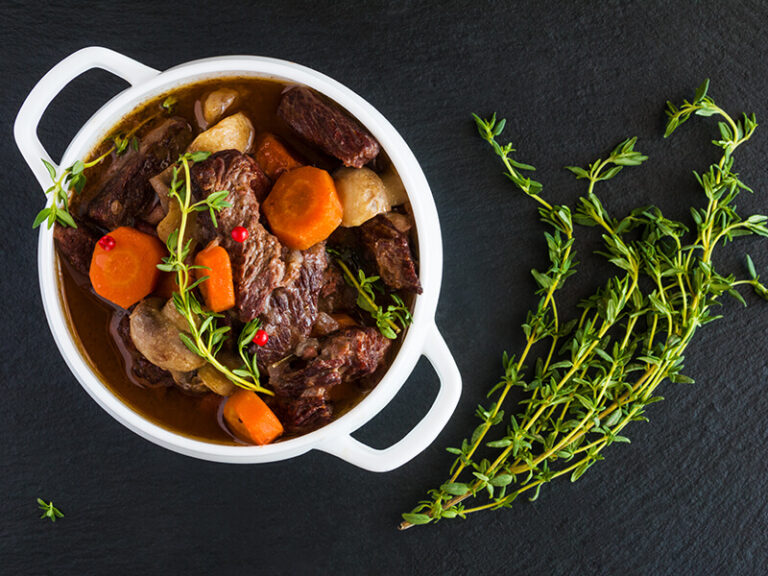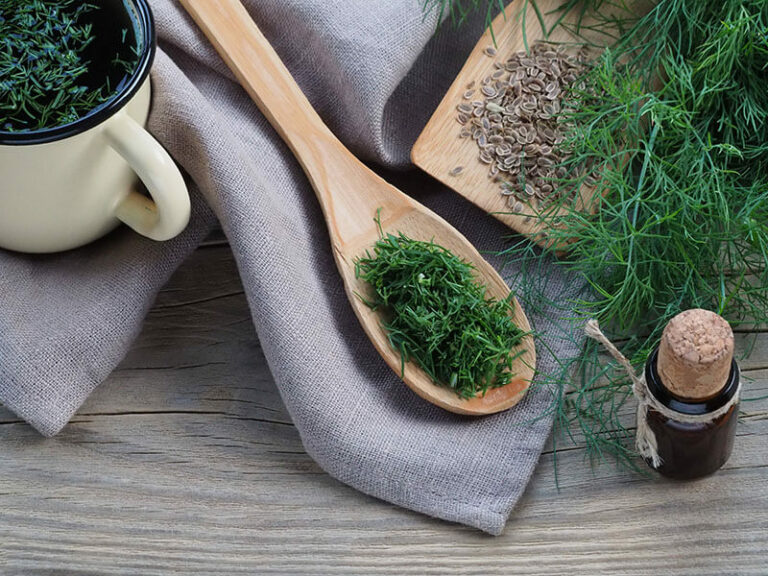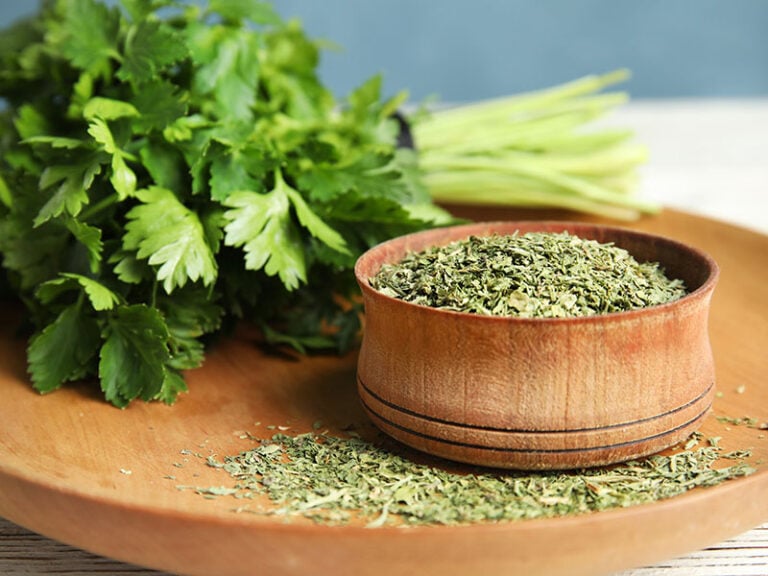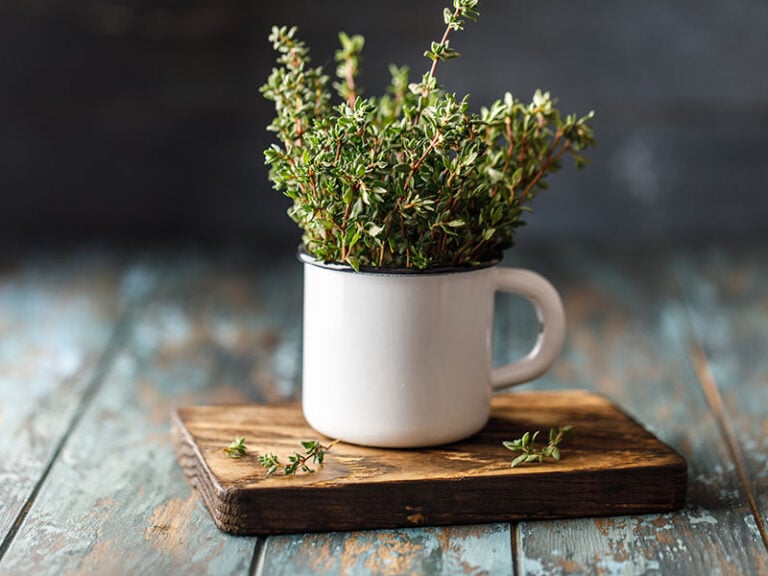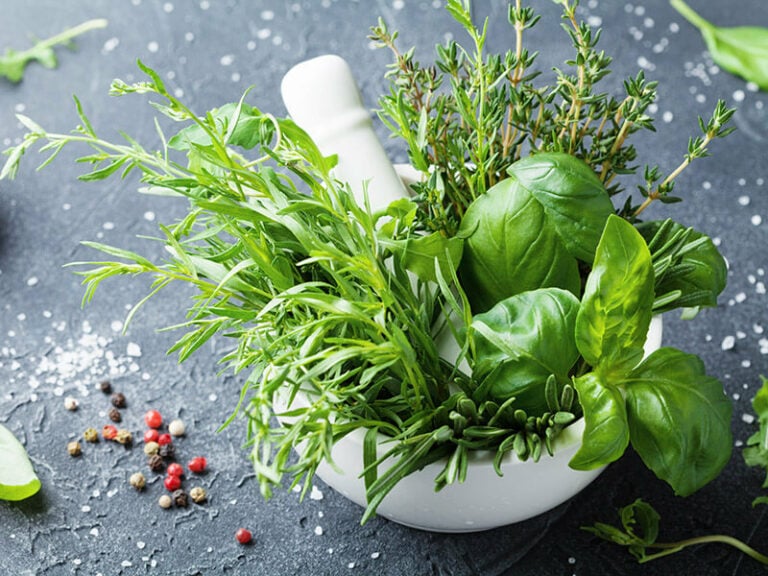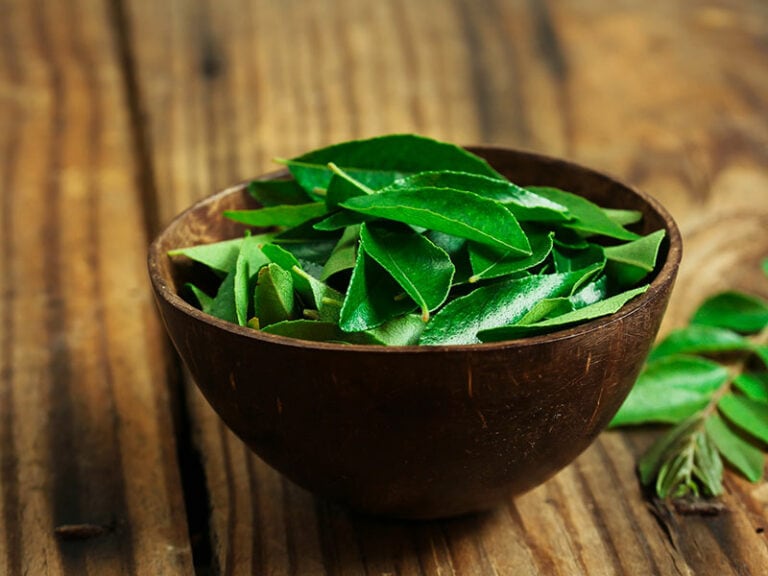How to store fresh cilantro probably remains a question mark for lots of vegetable lovers. Cilantro can be easily rotten when not being stored in the proper ways. In this article, I will introduce the five best hack tricks to store your fresh cilantro a lot longer.
You may have your own methods of storing herbs. But as cilantro comes in various types, you can’t miss this article if you want to store cilantro like a pro. So sit tight; the five best hack tricks for your cilantro will blow your mind.
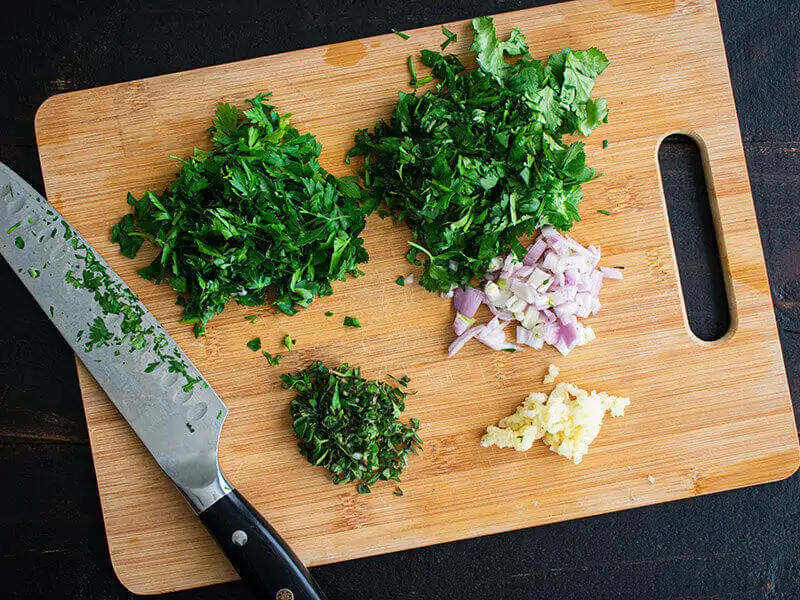
Storing Cilantro Can Be Much Easier Now
Cilantro is one of the herbaceous plants originating from Western Asia to South Africa. Some refer to it as coriander or Chinese parsley (1). since cilantro and parsley share several resemblances. Cilantro is used for particular purposes such as cooking, seasoning, medicine, etc.
The herb has various beneficial health effects, including lowering blood sugar and increasing resistance and immune systems. Cilantro, however, can get withered or perishable only after 3-4 days of normal storing.
Therefore, if you want to keep cilantro a lot fresher, I highly recommend you follow some best tricks below.
Watch this presentation if you still think parsley and cilantro are the same.
Reasons Why Cilantro Go Off So “Fast And Furious”
The most perishable parts of the herb are its slender leaves and smooth and soft stems. These parts of the cilantro are susceptible to excessive moisture, sunlight, temperature, and oxygen.
Moisture
Water is by far the most deciding reason that explains why the herbs go bad quickly. It helps to maintain the certain structure and shape of most vegetables and greenies. Besides, water can release and stabilize heat because of its high thermal conductivity property.
Like any other herb, Cilantro requires enough water to keep itself fresh. In the harvesting process, the herb has lost its essential moisture to look as green as needed. So it is a need to keep cilantro well hydrated after you buy it at the markets.
Sunlight
Sunlight plays a significant role in developing the physiological process of the plant. Nevertheless, after being cut or removed from the soil, the vegetables or herbs no longer need sunlight since excessive exposure to bright light can cause herbs to turn yellow.
Temperature
The temperature has a strong effect on the environment inside the herbs. The bacteria can proliferate at any temperature, and the most appropriate conditions are from 40°F to 140°C. (2) The longer the herbs stay in dangerous temperatures, the more likely the bacteria will multiply.
And cilantro is no exception. Despite many differences between dried and fresh cilantro, wrong temperatures can cause them to decay or lose their smell and flavor faster than they should. Inappropriate temperature also leads to losing essential vitamins, especially vitamin C.
Oxygen
Oxygen is also the driving factor that affects the quality and appearance of fruit as well as vegetables. Too much exposure to oxygen can turn your fresh cilantro into brown, removing its original freshness.
Confidently Store Fresh Cilantro With Basic Kitchen Tools!
Looking at your rotten cilantro, you will deeply sign and spend time wondering what happened with your little herbs. But do you know that your kitchen tools could already save you a lot of time? The methods below could provide answers to your how-to question.
Method 1: Store Cilantro At Cool Temperature With Damp Paper Towel
You may wonder how a paper towel could save your cilantro from being rotten, right? Its main role is to dry fresh cilantro and the surrounding environment, making the herb a lot fresher. This method will keep your cilantro fresh for up to 2 weeks.
Step 1: Sorting And Removing The Ends
After buying the herbs at the market, the very first thing you should do is cut the ends. Though in some markets, the herbs would undergo preliminary processing, or post-harvest processing before they are presented in the stalls. However, cilantro still contains dirt.
Therefore, using kitchen shears to remove undesirable substances from the ends is highly advisable in order to stay healthy. The process may include procedures such as:
- Removing the dirt and foreign substances on its leaves and herbs
- Getting rid of the damaged parts
- Sieving and trimming
Those practices above can be done by hand easily. You can also consider trimming the stems under cool or running water in order not to cause unnecessary shock to the plant as well as keep it a lot fresher.
If you still wonder how you can pick cilantro, please refer to the following video. It would show you how.
Step 2: Washing The Cilantro
Vegetables and fruits may have small insects and dirt after being bought at the supermarkets. Hence, soaking the cilantro under cool water is a must. After sorting and removing the ends, cilantro still contains some debris and unwanted substances; therefore, cooling or running water can give a hand to cleaning all the dirt, giving us a greener and fresher plant.
You can follow our procedures below:
- Prepare regular water and a plate. Note: Some people would prefer putting salt in this process; however, using salt to clean the dirt is not a good option in washing.
- Gently put your cilantro on the water plate. You can use your hand to scrape and brush the plant during the process to clean the remaining debris.
- Five to ten minutes of washing is preferable.
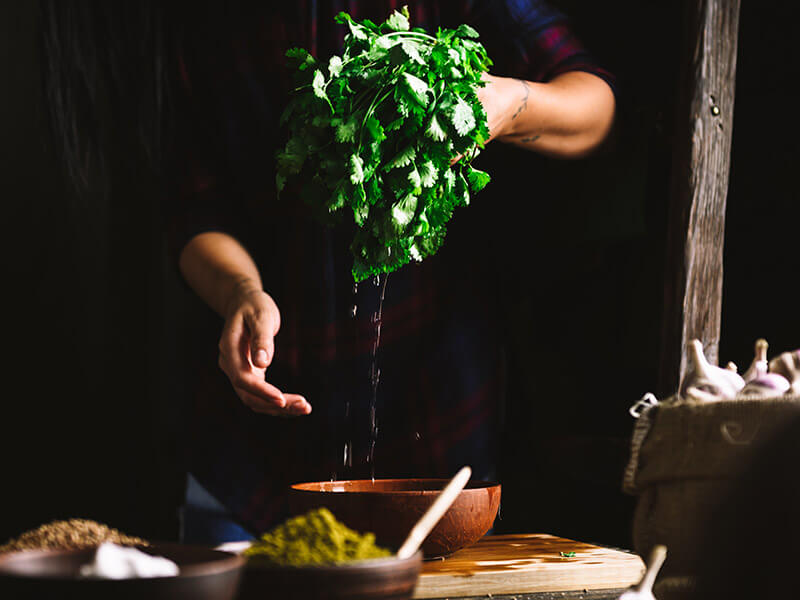
Step 3: Remove Excess Water Washing Cilantro Under Cool Water
After dipping the herb into the water, you now can take as much as water that remains on their leaves. Removing the moisture from the plant can avoid any discolored and wilted leaves.
Step 4: Wrap The Cilantro In A Wet Paper Towel
Next, you can use a mildly wet paper or dry towel to wrap it. The towel can not only help to soak up the leftover water but create appropriate moisturization, keeping the plant a lot greener.
Step 5: Place The Cilantro In An Airtight Container
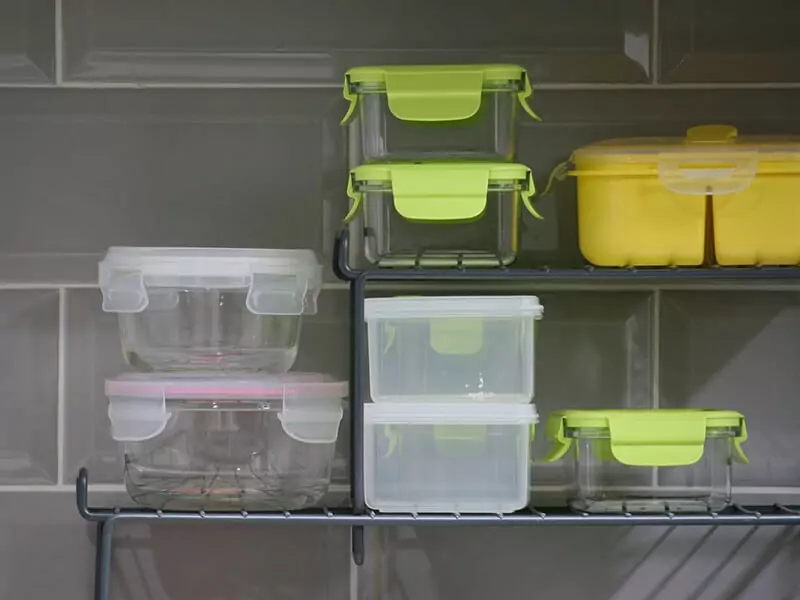
At home, your fridge may already contain a lot of vegetables and plants, such as onions or spring onions, etc. When these plants are stored in the same refrigerator without any protection, they can absorb the smell of the others.
This would lead to moisture loss in the surrounding area, accelerating the dehydration process of the herbs. Therefore, you need a safer option such as a ziplock bag in order to keep our cilantro fresh longer.
Step 6: Store At Cool Temperature
Finally, you can complete the storing process of your cilantro in the fridge or cooling temperature. The dry humid atmosphere inside the fridge eliminates humidity, slowing down the proliferation of bacteria. Cilantro can retain its quality for a longer period of time.
Method 2: Store Jars Of Cilantro In The Refrigerator
A water jar can be easily forgotten in your kitchen because of its limited uses. Now, you had better clean the jar and make use of it as the rarely used container could save your cilantro. And your cilantro could be fresh for up to 2 weeks.
Step 1: Prepare A Water Jar
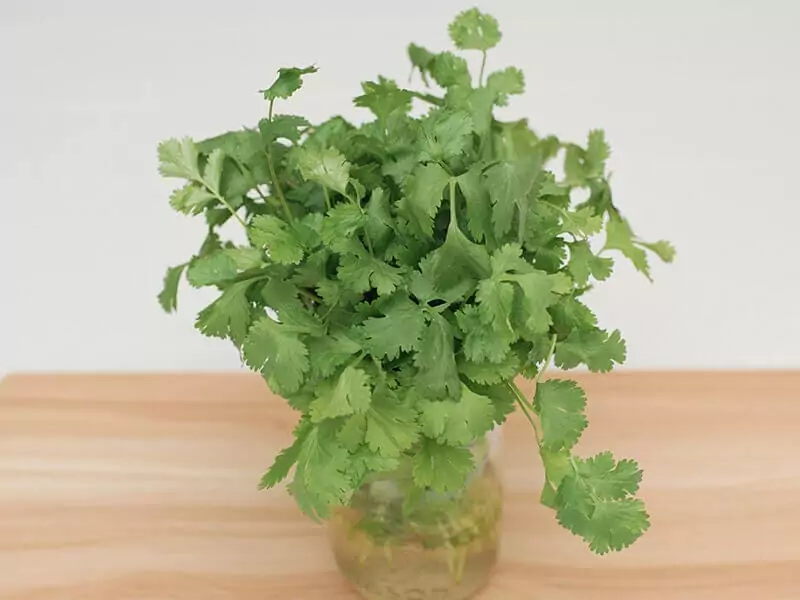
First, you fill the jar with 2-3 inches of water. The shape and size of the water jar depend on the amount of cilantro you want to store. Since our aim at this stage is to dip the stems into the water for storing the moisture, the jar should fit well.
Step 2: Dry Out The Cilantro
After providing the herb with some water, you can take it out and dry it out using a paper towel. You should pat the herbs gently; otherwise, the herbs would get bruised.
Step 3: Cut The Stems
Now, you can use a sharp knife kitchen to cut the stems since they contain dirt and unwanted substances. This helps avoid the bacteria and insects that remain on the cilantro.
Step 4: Submerge Part Of Cilantro Into Water
The stems are removed. You can now grab all the herbs from the cutting board and put their ending parts into the water jar. Make sure that its leaves and body have no contact with water.
Step 5: Use A Plastic Bag To Cover Its Leaves And Body
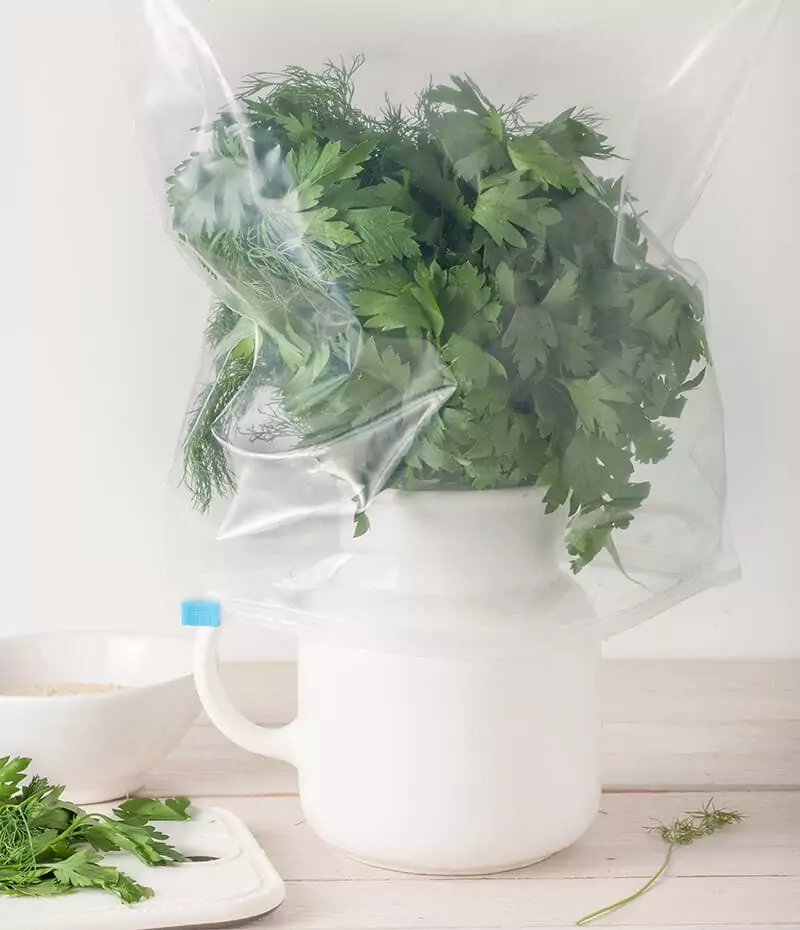
Gently use a plastic bag to cover the herbs. You can reuse the plastic bag that is already in your kitchen; however, please check whether it contains dirt, then remove it. Otherwise, the bacteria inside the bag can do harm to the herbs.
Step 6: Place The Jar In The Refrigerator
Finally, you put jars of cilantro into the refrigerator. Remember to change the water when it starts to discolor and use it within 2 weeks.
Method 3: Store Cilantro In Airtight Container (Refrigerator)
For this method, you can store fresh cilantro for up to 4 weeks. Read through the information below and see how a plastic bag could prolong the herb’s life.
Step 1: Trim The Ends
Though supermarkets usually ensure the veggies’ cleanliness. However, it can not be considered insurance for edible herbs. You should follow the instructions below:
- Discard any leaves that do not look good
- Trim the excess stems if needed
The ends are home to dirt and fertilizer, especially chemical fertilizers that could do harm to the herbs themselves as well as the user. Since the bacteria surrounding the ends can proliferate greatly and become detrimental to your family’s health if the herbs are not trimmed properly.
Step 2: Dry The Cilantro In Two Ways
Unlike the first method, the cilantro is then dried instead of dipping in water. There are two choices of drying that you can go for:
- 1st Choice: Dry the cilantro by using a paper towel (Like the first method)
- 2nd Choice: When your herb is a bit moist, you can tie the herbs into small bunches. Then hang them in the sun till the water evaporates.
NOTE: You should hang the bunches with the leaves down so oils flow from the stem into the leaves.
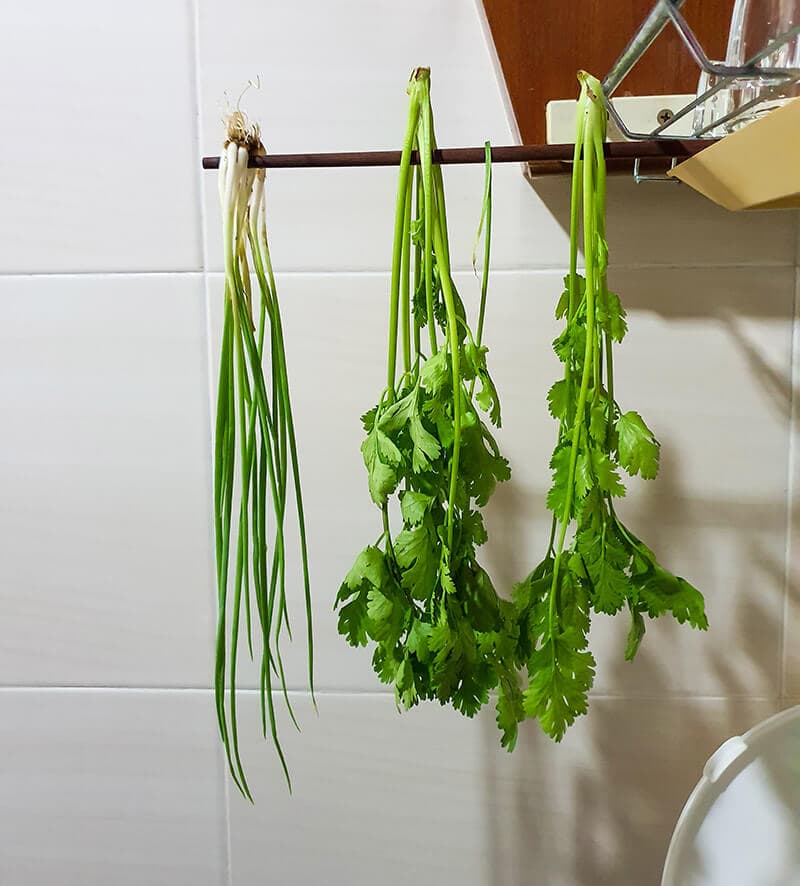
Step 3: Put Cilantro Into A Plastic Container
After dehydrating the herbs, you can now collect them. You can follow the procedures below:
- First, prepare a plastic airtight container and some tissue
- Second, put a sheet of tissue inside the container so that it fits properly
- Thirdly, layer a bunch of cilantro on top
- Finally, remake the process until the container is full; after that, seal the plastic container.
Step 4: Keep In The Refrigerator
Well done! Now you can put boxes of cilantro in the refrigerator. For this method, your cilantro could be fresh for weeks (up to 4 weeks if your cilantro is dry enough).
Method 4: Store Frozen Cilantro Cubes In A Freezer
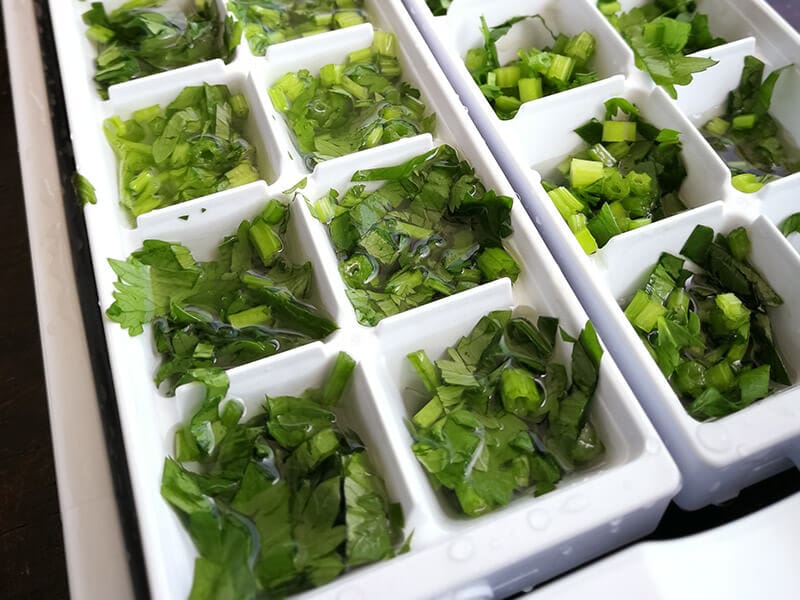
You may be pretty surprised then wonder how the little cubes can solve your problems. However, they really can store fresh cilantro for up to 24 weeks. Those steps below would explain the reason why.
Step 1: Prepare Clean And Dry Cilantro
As always, you will take some time to wash your fresh cilantro. The steps would help you to get dirty-free herbs. If you care enough about their cleanliness, you can follow some of these notes:
- Remove dead ends and wilted leaves
- Dip your cilantro into a water container
- Gently rub the herbs
- Remake the process from 2 to 3 times
- Dry cilantro by using a paper towel
Step 2: Use A Blender To Crush Cilantro
Next, you will use your blender to crush the herbs. Instead of keeping the cilantro’s original shape, your herb in this method would be crushed into a thick puree. While the blender is still running, you should drizzle water until the mixture is done.
Instead of using pure water, you can also pour olive oil into the cilantro puree, making your food taste much better.
Do not miss this presentation if you want to know how to chop cilantro step by step.
Step 3: Put The Mixture Into Small Ice Cubes
After blending cilantro with olive oil, you can divide the mixture into each ice cube. Then, you add fresh water to each cube until the cube is full. Finally, you can put the ice cube tray into a freezer. Until your cilantro is frozen, you can transfer it into airtight plastic bags.
For this method, you can store your cilantro for up to 6 months. Each time you want to use it, you can defrost ice cubes and take out the herbs. The cool temperature would help the cilantro to retain its original taste.
One minus point of this storing method is that your frozen cilantro would lose much of its green color, making it look quite dreadful to some people. The herb, therefore, should be stirred into soups rather than used for decoration purposes.
Can you freeze cilantro? Yes, you can and here is how.
Method 5: Dry Cilantro With Oven And Store At Room Temperature
You have read some methods that are mostly done by using a freezer. Do you know, however, there is a method that has yet to be mentioned? It is to make use of an oven that is available in your kitchen. Your cilantro would prolong its life up to 48 weeks.
Step 1: Wash And Chop Cilantro Into Pieces
First of all, you should remove dying leaves and dirt through washing. In this method, you would not keep the original shape of the cilantro. After washing, you would use a sharp knife to chop it into pieces.
Step 2: Dry Fresh Cilantro
For drying, some people would choose to use paper towels or place several bunches of cilantro in a dry and well-ventilated place.
However, some places may not have good weather conditions for drying outside. Therefore, instead of using paper towels or drying outside, you can dry cilantro by using an oven. You may need some instructions below:
- First of all, spread cilantro onto baking sheets
- Secondly, select the highest power mode and turn on the oven for around 3 minutes
- Finally, if your cilantro is not dry enough, you should redo the process.
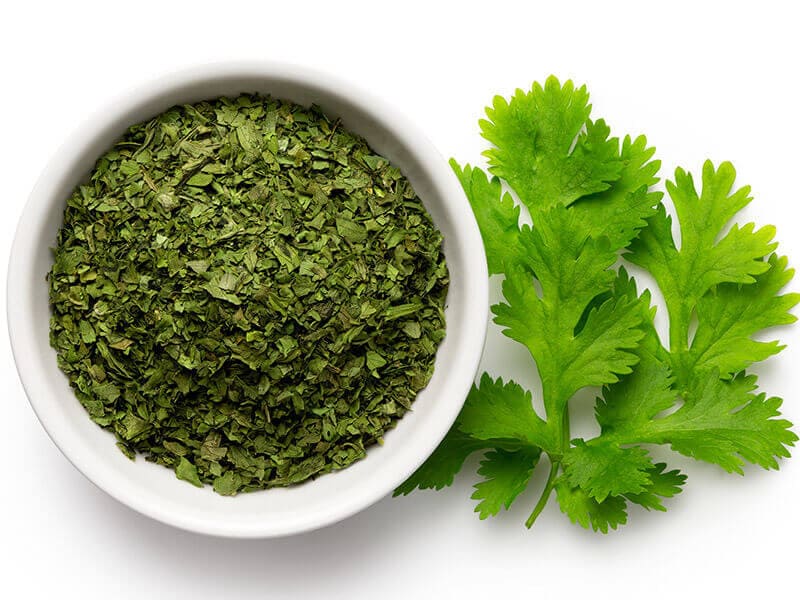
Step 3: Store At Room Temperature
After drying, now you can equally divide the herbs into each plastic bag for long-term use. For this method, you can not use leaves to decorate your food. It is mostly used for salad bowls or soup.
If you can not believe that cilantro can be stored by this method, you must watch this presentation now.
Each Method, Each Shelf Life
The five methods presented are not an answer to all of your problems with fresh cilantro. Each way would have its own advantages and disadvantages. You can look at the table below to consider which one suits you best.
Point Out Prominent Signs Of Inedible Cilantro
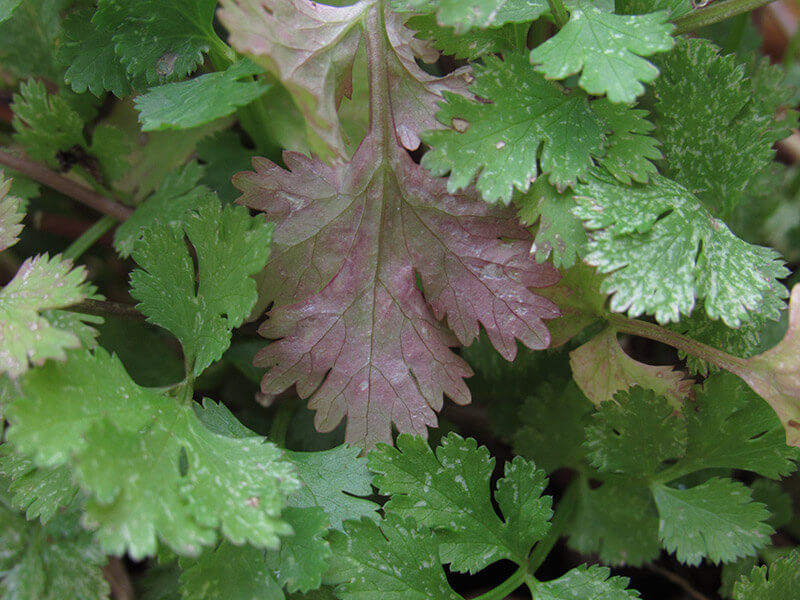
Fresh cilantro is usually used for food decoration and seasoning. The discolored or uncommon appearance of cilantro reduces the appetite and leads to food poisoning. Below are some common signs of inedible cilantro.
Yellow Spots
When seeing the leaves turning yellow, you had better discard or take out the leaves. The yellow color may be caused by too much nitrogen fertilizer or fatal root rot. Consuming these leaves may result in stomachache or vomiting.
Pungent Smell
You can try to smell your herbs. In case, cilantro is likely earthly like it normally would be. However, if your herbs seem a bit “off” or smell sour or pungent, it is highly recommended you cut them off. Fresh and edible cilantro does not have such a strong scent at all.
Weak Flavor
Unlike other herbs, cilantro would lose its flavor once past its prime. This also means your cilantro is no longer usable as it almost has little or no flavor. In most dishes, cilantro is usually added at the end of the cooking process.
Storing Fresh Cilantro: The Dos And Don’ts
While using the five methods above, there are some notes that you should bear in mind. Let’s take a look at the five following tips.
Tip 1: Do Dry Out The Cilantro Right After Washing
After being soaked in cool water, the cilantro is full of moisture. The high level of moisturizing increases the freshness and the greenness of the herbs; however, it is the ideal environment for bacteria growth. So one way to prevent its reproduction is to dry out the cilantro.
Tip 2: Do Store Your Fresh Cilantro In Plastic Boxes
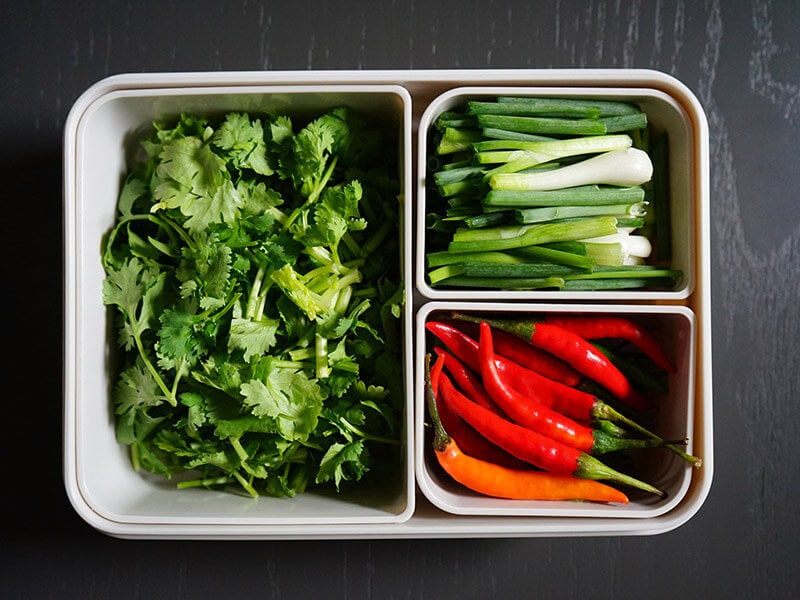
Your refrigerator must be loaded with lots of vegetables and fruits. But do you know some vegetables, such as garlic, can get rid of the cilantro smell when they are stored in the same fridge? For that reason, cilantro should be kept in separate boxes from the garlic or onions.
Tip 3: Do Moderate Your Fridge’s Temperature When Storing Cilantro
Herbs are usually sensitive to temperature since damage can occur to plants when they are exposed to extreme conditions. For species such as cilantro, warm weather can result in bitter-tasting foliage. So controlling temperature is of importance.
Tip 4: Don’t Pat Cilantro Too Much When Washing It
Patting cilantro can remove dirt and debris, eliminating unhealthy factors inside the herb. One thing you should bear in mind is not to pat cilantro too much because its stems and leaves are quite delicate. Excessive patting may do more harm than good to cilantro.
Tip 5: Don’t Put Fresh Cilantro Outside For Hours Before Storing it
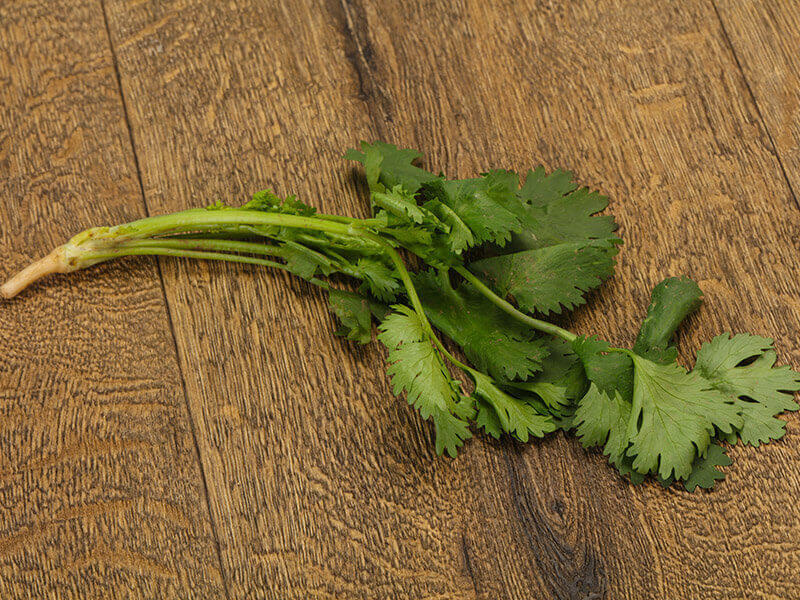
After going to the market, you may sometimes leave food and veggies outside for hours because of your busy schedule. However, the water inside herbs would evaporate gradually at room temperature. Consequently, the process causes the herb to lose its freshness.
FAQs
If you have gotten this far, I believe you may still have some concerns about the storing methods. So why don’t you spend extra time to equip yourself with some storing tips? It would definitely be worth your time.
Storing Fresh Cilantro Is No Longer A Problem!
Now, storing fresh cilantro would definitely no longer be a challenging task for you since the mentioned methods above are keys to your problems. You should memorize the information so as to utilize it in the near future.
So, did you keep your cilantro fresher and longer with these methods? Please share your experience and thoughts with others via comments. And if you have better ways of storing fresh cilantro, please let them know. Other readers are waiting for your beautiful ideas! Lots of love!

References
- healthline.com. 2017. Parsley Vs. Cilantro: What’s The Difference?
- ask.usda.gov. Feb 7th, 2022. At What Temperature Do Bacteria Grow The Fastest?
- freshpont.com. 2022. Herbs, Cilantro.

